![]()
![]()
![]()
Use LEFT and RIGHT arrow keys to navigate between flashcards;
Use UP and DOWN arrow keys to flip the card;
H to show hint;
A reads text to speech;
57 Cards in this Set
- Front
- Back
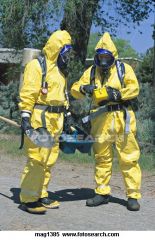
Level A PPE includes
|
Coveralls (optional)
Long underwear (optional) Gloves, outer, chemical resistant Boots, chemical resistant, steel toe, and shank Hard hat (optional) Disposable gloves and boots (optional) two way radios |
|
|
What are some conditions when level A must be worn?
|
When the hazard has been identified and requires the highest level of protection, or when there is a high concentration of atmospheric vapors.
|
|
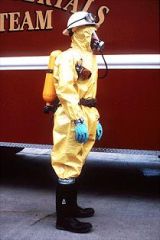
Level B PPE include
|
Coveralls (optional), Gloves, outer, chemical-resistant, gloves, inner, chemical-resistant, Boots, outer, chemical-resistant, steel toe and shank, hard hat, two-way radios, face shield (optional), chemical tape
|
|
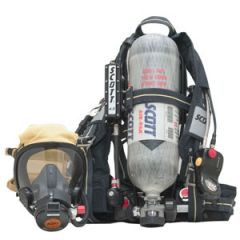
Level B requires what kinda of Respirator?
|
an self contained breathing apparatus (SCBA), or a supplied air respirator (SAR)
|
|
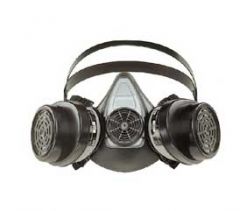
What is the only difference between level B PPE and level C ppe
|
Level B must have a positive pressure breathing apparatus like the SCBA or the SAR, Level C requires an Air Purifying Respirator (APR)
|
|
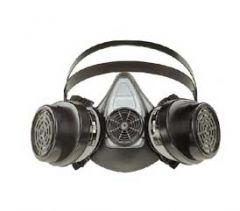
What are some restrictions of the air purifying respirator?
|
Can not breath in oxygen deficient area's or anything below 19.5% or 23.5%
|
|
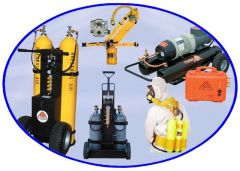
How long is the hose on a Supplied Air Respirator?
|
300 Feet
|
|
|
To select the proper respiratory protection. you must know key information about the chemical
|
Name of chemical, Concentration, Hazard, expected exposure, and OSHA requirements.
|
|
|
To discover of the name of the chemical what tools could you use.
|
MSDS, CHEMTREC, Shipping papers, ERG
|
|
|
How do you determine the concentration of a hazard
|
IDLH, Oxygen levels, Monitoring equipment.
|
|
|
How can you determine the Hazard of a chemical?
|
MSDS, CHEMTREC, ERG, NIOSH, Other reliable references, splash, vapors, corrosive, etc
|
|
|
what are the two options for an APR?
|
You can have a full face piece or a nose cup
|
|
|
when wearing a SAR what else must you have?
|
an Egress system ( a small bottle of oxygen to use in case of an emergency, only provides around 5 to 10 minutes of air to exit the situation.
|
|
|
In Level A, if your SCBA fails how many minutes of air do you have in your Level A suit
|
5-10 minutes.
|
|
|
What factors should you use when referring to Risk assessment to selecting the proper chemical protective clothing for a specified action option
|
Identify the hazards present, estimate the likelihood of exposure, understand the consequence of exposure, determine the risk
|
|
|
What factors should you use to selecting the proper chemical protective clothing for a specified action option
|
Overall suit integrity, materials chemical resistance, materials physical properties, design features, service life, cost, known hazards, potential of exposure.
|
|
|
Suit degradation refers to what two classifications.
|
Chemical: the weakening of a material by exposure to chemicals
Physical: weakening or destruction of a material caused by rubbing against rough surfaces |
|
|
Penetration of a suit refers to what?
|
The movement of a chemical through the suit's closures, cracks, or tears
|
|
|
Permeation of a suit refers to what?
|
The process by which a hazardous material moves through a given material on the molecular level.
|
|
|
NFPA 1991 requires that that suits have at least how many hours of permeation resistance?
|
3 hours
|
|
|
What are some indications of degradation of PPE clothing
|
Stiffness or excess pliability, tears, cuts or abrasions, damage to zippers or closures, soft sticky areas.
|
|
|
What are the three types of cooling systems in PPE suits?
|
Air cooled, Ice cooled, Water cooled.
|
|
|
what are some psychological stresses that can affect users in PPE
|
Low dexterity mobility, low visibility, communication problems, physical stress, claustrophobia, limited dexterity, and heat stress.
|
|
|
how would you describe Absorption when referring to decontamination
|
to absorb liquid contaminants without changing their properties
|
|
|
what is a disadvantage of absorption?
|
absorbed contaminant remains hazardous
|
|
|
what could you use to absorb a chemical?
|
Soil, sand, and absorbent pillows/pads
|
|
|
What is Adsorption?
|
Contaminant sticks to the sorbent material without adding to the volume of the sorbent. The resulting chemical reaction is heat
|
|
|
What is a disadvantage of Adsorption?
|
causes heat, that could cause spontaneous combustion
|
|
|
What is Chemical Degradation?
|
Waiting to allow a chemical to lose potency.
|
|
|
what is Dilution?
|
adding a non-hazardous liquid solution, to lower the concentration
|
|
|
what is a disadvantage of Dilution
|
Could increase the size of the risk, may need a large amount of non-hazardous liquid.
|
|
|
What is Evaporation
|
To allow a chemical to evaporate
|
|
|
What is neutralization?
|
To add a chemical to a contaminant, in order to change the chemical structure. for example adding a base to an acid to neutralize it.
|
|
|
What is solidification?
|
To add a chemical to the contaminant that will convert its physical sate from liquid to solid
|
|
|
What is vacuuming?
|
To gather the contaminant by sucking it from the surface and hard to reach areas. (mostly used in radiological fallout)
|
|
|
What is washing?
|
to remove contamination by decontaminating with water or soapy water.
|
|
|
What is overpacking?
|
Used as a physical control technique to contain hazardous materials (placing a 55 gal drum in an overpack)
|
|
|
What is patching?
|
used as a physical control technique to temporarily stop or reduce hazardous material flow.
|
|
|
what is plugging?
|
used as a physical control technique to temporarily stop or reduce hazardous material flow.
|
|
|
What must be used to secure a patch?
|
Straps, clamps, and adhesives.
|
|
|
TC-406 (non pressure) trucks use what kind of transfer method?
|
Vacuum pumps, or POWER TAKE OFF PUMPS (PTO's)
|
|
|
TC-406 (low pressure) trucks use what kind of transfer method?
|
Vacuum pumps, or POWER TAKE OFF PUMPS (PTO's)
|
|
|
TC-312 (Corrosive) trucks use what type of transfer method?
|
Vacuum pumps, or POWER TAKE OFF PUMPS (PTO's)
|
|
|
TC-331 (pressure) trucks use what kind of transfer method?
|
Vapor compressor, and liquid pump, vapor pressure, and compressed air
|
|
|
How can you be certain that a person working on your scene has the proper certification to work on the scene?
|
the DODFFCERT database
|
|
|
According to NFPA 472 what must all responders must have this to work on scene
|
appropriate level of certifications, and competencies.
|
|
|
Hot and warm zones are supervised by who?
|
the branch officer
|
|
|
In a confined space what at what LEL point would you evacuate?
|
10%
|
|
|
What pre entry activities msust be performed?
|
Identification of: Safety officer, control zones, escape route, designated withdrawal signal, identification of safe locations that are uphill and upwind.
|
|
|
What do branch managers do?
|
Managers the activities that apply directly to the primary mission, responsible for allocation and assigning resources to control the incident, the IC may perform this function if qualified during small incidents
|
|
|
Describe HAZMAT branch safety
|
Designated by the IC, must be knowledgeable in the operations being conducted, responsible for identifying and evaluating hazards, provides direction regarding safety of operations
|
|
|
Entry manager does what?
|
Responsible for the operations of the entry and exit, makes recommendations concerning control activities IN THE HOT ZONE
|
|
|
What are the responsibilities of of information and research personnel
|
Developing, documenting and coordinating the information gathered during an incident, evacuation considerations, ppe selection
|
|
|
Reconnaissance personnel are responsible for what
|
gathering information about the layout of the incident scene and other factors that may have an influence on the incident.
|
|
|
Reconnaissance personnel are responsible for a checklist, what does it include
|
access routs, egress routes, weather, utilities, drainage, topography, water supplies, exposures, number type and condition of containers. coordinates functions with ops officer.
|
|
|
what does ALARA stand for when referring to contamination?
|
As low as reasonably possible
|
|
|
What is the highest diastolic blood pressure allowed in a person before entering PPE
|
105 Diastolic.
|

